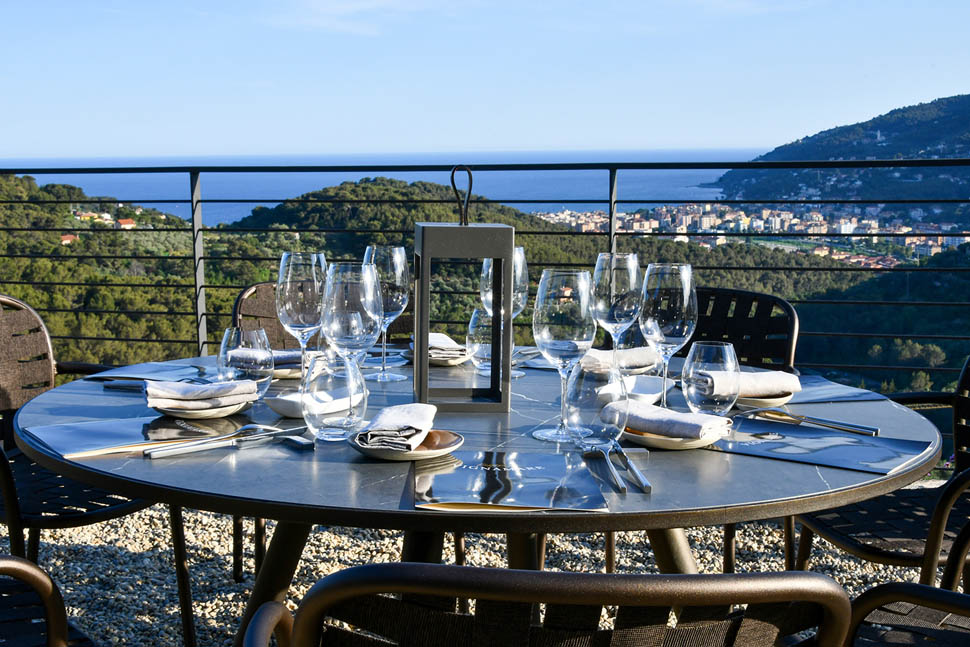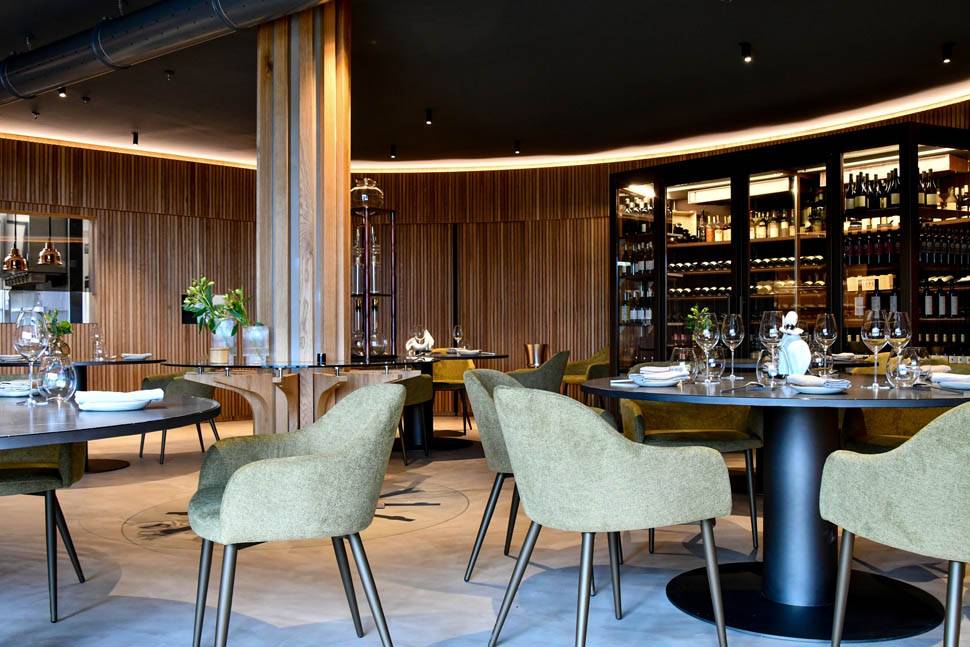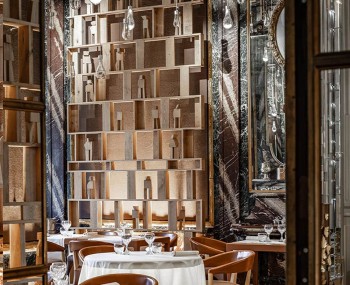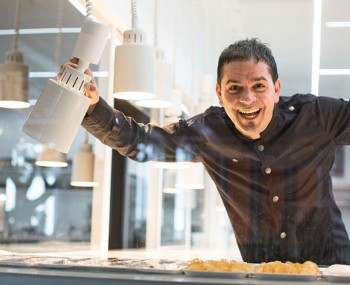It is Peq Agri's flagship restaurant, amid sustainability and acknowledgements as it was a awarded with a red and a green Michelin star. Surrounded by a magnificent view of the Gulf of Andora, Giorgio Servetto’s cuisine is deeply rooted in self-production.
The view of the Gulf of Andora from Terrazza Praiè, once admired, quickly becomes an everlasting memory. Vignamare, located right there is a truly unique restaurant. Among the vineyards of Colla Micheri, it carries the name of the signature wine produced by Lupi winery, part of the Peq Agri system that we have already had the opportunity to tell about.

The area devoted to haute cuisine is the result of a very unique architectural design that embraces and merges with the surrounding landscape. Originally, in the 1970s, it was a concrete tank for irrigation water, then left sitting idle and in a state of disrepair. Today, it is an elegant, warm and intimate hospitality venue that features a stunning dehors space with unmatched views of the Gulf of Andora and the mountains around. The restaurant can be reached by foot or electric kart through a driveway through the vineyards' rows of Vermentino.

Here Giorgio Servetto, a long-established Ligurian chef who viscerally loves his home land, has been able to forge a gastronomic environment of remarkable charm.

The chef and the restaurant
Servetto's career starts out early: "I was introduced to this industry when I was 14 years old, at the Hotelier in Finale Ligure. The greatest luck was to have as professors some chefs who were also active in the field, such as Mauro Poliotto, who, working purely for hotel restaurants of a certain level, always fought to give a cutting-edge education. Then again Gianluigi Strobino, head chef at Paul Bocuse's and sous chef at Alain Ducasse's Louis XV in Paris. It was the mid-1990s and I already knew the local traditions, but when you run into these personalities you realize that cuisine is something else."

Giorgio's first relevant experience was at Fornace di Barbablu in Sant'Ermete,alongside Giuseppe Ricchebuono, where he took a direct approach to products and quality, even with large volumes; then he moved on to Antico Genovese in Varazze, in which he discovered the secrets of charcuterie. And he begins to gain awareness of the core principles that mark his cuisine: "Today we too often forget that this profession is not just about transforming raw materials into dishes, but it is about understanding the origin of products and their specificity, being able to do the math well and analyze the details."

Again he comes back to the Fornace to revolutionize its format with Ricchebuono: "We used to do large numbers, up to seven hundred guests during the four days we were open, but Giuse wanted to change and look after things in detail; it was 1999, and in 2001 the first Michelin star came after great sacrifices both financial and professional, because it is not easy to go from hundreds covers to thirty, with a jolt of no small investment."

A born 1975, Servetto at 24 was already a lecturer at the Bergese Institute in Sestri: "Yet combining catering and teaching soon proved to be too demanding, and I realized I had to make a definite choice." After leaving teaching, he opened his own restaurant, U sciarattu, in Alassio and shortly thereafter the Locanda dell'Asino with Gianni Gaibisso, to refine his search for a cuisine style geared toward the genuineness of the product and an uncompromising vision of quality: "An increasingly focused work on raw material and an ever closer collaboration with small local artisans, thanks also to the great harmony and sensitivity with Gianni, a true gourmand."


Talking to Giorgio Servetto, one realizes to be dealing with a chef of great creativity and inquisitiveness, who is dedicated to constant research, a great lover of wine and very dynamic: "One needs to have resilience, a thirst for knowledge and to not remain stuck to one's own ideas. By comparing, the mind opens to uncharted horizons. I enjoy devoting moments to discovering new things, meeting great masters and getting to know producers up close. It is a constant process of learning. With commitment, willingness and sacrifice you always get to the goal. It has been and still is a beautiful journey."

Before arriving at Nove di Villa La Pergola, where he earned a Michelin star in 2021, he held several important internships, including with Enrico Bartolini and Gaetano Trovato. Finally, he lands at Vignamare, where very quickly he first gets a Michelin green star in 2023, within just six months of opening, and then in 2024 the red Michelin star is awarded, sealing the first milestone on a path that promises to be an important one.

"I immediately embraced this project, it was all about doing high-quality, research cuisine with a different formula. Here the luxury lies in utter simplicity while, at the same time, I have at my disposal raw materials of the highest level, naturally produced and truly kilometer zero. Vignamare is also part of an all-round eco-sustainable project, and I can dispose of equipment that helps me do my job to the best of my ability. I fully embraced Peq Agri's philosophy, which in some ways takes me back to my roots, since my parents were farmers and we had an estate in Sassello. Here at Vignamare, I can finally realize what I have always had within me. We own three hectares of vegetable garden, and one can easily say that it is the restaurant that serves agriculture, not vice versa. Everyday, we transform what the people who work with us take care of, and everything is repurposed and adapted for consuming.

Another major thing for me is to have had the chance to get to know real flavors, such as freshly milked milk or alpine butter. Here we experiment and create different tastes and flavors every day, with charcuterie, cheeses, vegetables. We work through trial and error, and of course we make mistakes, because working in direct contact with a vegetable garden also means getting to know and rediscover more about the land and its composition, seasonality, and adapting to climate change. Nothing is taken for granted, we start from the thousand-year-old tradition of this land and experiment, create, innovate, day after day. In the end, the outcome always gives great fulfillment."

Cuisine, at Vignamare, is decidedly unique: self-production reaches 75 percent of the requirement, meat and products derived from chickens, rabbits, goats, sheep are used and beef and pork will be coming soon. In addition to this, the wine list features only bottles from the group's own wineries, all Ligurian, which are Lupi, Praié, Guglierame, and Berry&Berry, but it is nonetheless full of surprising wine gems: "At first I wasn't convinced because I found it a limiting choice, but I had to change my mind."
The dishes

On the premise that Vignamare's menu constantly changes according to the seasons' rhythm and to the products available in their gardens, the dishes tasted during our visit impressed us, from the very beginning to the end.
We started with a variation on artichokes, steamed then fried to preserve their crispness, and a flavor reminiscent of the nutty note when raw, a cream obtained from the overcooked and braised artichoke, and finally a stuffing with the grilled vegetable: "To recall the barbecue and the warm spring days under Easter, when we ate kid and artichokes. I wanted to convey the different taste tenors that this magnificent and very versatile vegetable can claim," Giorgio explains.

Next comes the heated "pansotto", whose dough is made with celeriac, stuffed with "prebuggiun" (a mixture of wild and aromatic herbs), Parmigiano Reggiano and sheep milk ricotta. It is laid on a vegetable ragu made with Granaccia and a topinambur béchamel: "It is a memory of my adolescence that I wanted to transform into an almost entirely vegetable dish. On Sundays, Maria, my mother, always made excessive productions, so that the pansotti could be reheated for the evening or lunch on the next day. And with a light toasting in the pan, they were better and tastier than freshly prepared."

Successful also is the dish on the now non-laying hen, boiled down to a white stock and a tasty meat, seasoned with truffle and steamed. It is served with salsa verde, raw, cooked and sweet and sour vegetables. To top it off, a jelly of the stock itself reminiscent of aspic. An excellent dish with 100 percent Peq Agri products are "bottoni di asparagi": "It sums up the work we do on the farm, because we use vegetables from our Asparagia, a Slow Food presidium. I use a cooked dough to pack the filling of freshly blanched green asparagus seasoned with our goat parmesan cheese, garlic and parsley. Then I steam and roast them in a pan. Accompanying them is a kind of savory eggnog, whipped with a white stock flavored with our smoked bacon. Garlic foam and savory emulsion complete with a ligurian note. We finally garnish with roasted asparagus and chili."


The mullet "gnocco" is also excellent, at the base of which is a classic dough with quarantine potatoes and Ligurian herbs; the filling consists of mullet ragu and the raw mullets themselves. The sauce is a "livornese-style" mullet reduction, garnished with its freshly seared meat. "This dish is a tribute to childhood memories and to my father, when we would go fishing and on the way back he would make his legendary soup." A clever invention is the Vegetable Rossini, in which the chef used all the original ingredients, but substituting fillet, foie gras and brown stock: "We have a beet pureed in butter, a crispy crostone, the fillet is replaced by a tournedos of turnip cooked on the grill and dried in the oven, the foie gras by an avocado escalope and the stock by a vegetable reduction scented with Cervo Rosso, our Petit Verdot. Maldon salt and truffle petals to garnish."

Of great juiciness was the "capretto e radici", kid and roots, another memory of family life: "When kid was prepared to be grilled, the belly was pulled off to make a separate cooking and make the ribs easier to eat. The same was then stewed and turned into fricassee: it was usually the last course of Easter." The belly in Vignamare is served dry-cooked at a low temperature, which makes it soft and melting; it is stuffed with the cooked shoulder of kid in fricassee and then roasted in a pan. To top it off, leg confit, truffled offal pâté, a lemon meat stock, scorzonera puree, and roasted bitterroot.

The meal ends on a high note with "Dolce sa essere l'ape", "Bee knows how to be sweet", which Servetto tells us about as follows : "It is a tribute to and a manifesto of sensitivity to an insect to which we owe life on our planet. At the base is a cocoa butter and pollen crumble, an asparagus and red turnip gelée, a wild fennel gel, a chamomile gel, and a lemon gel. Finally, a ginger carrot chutney and a self-made goat (or sheep) ricotta cheesecake, and a representation of bees made from a honey and almond paste Bavarian cream."

Contacts
Vignamare- Peq Agri
Strada Castello 20- 17051 Andora (SV)
e-mail: vignamare@peqagri.it
Phone: 351 713 5050











